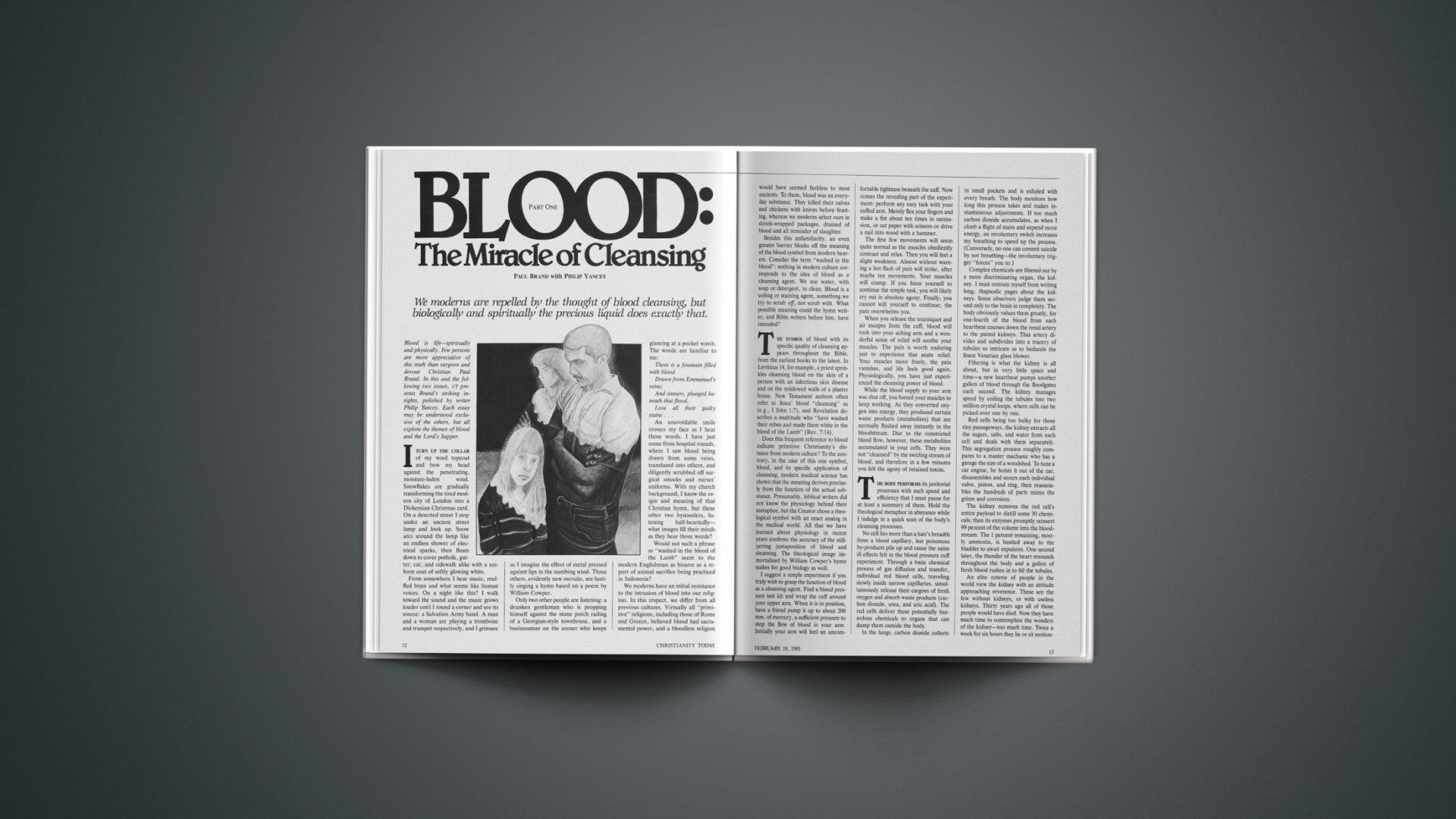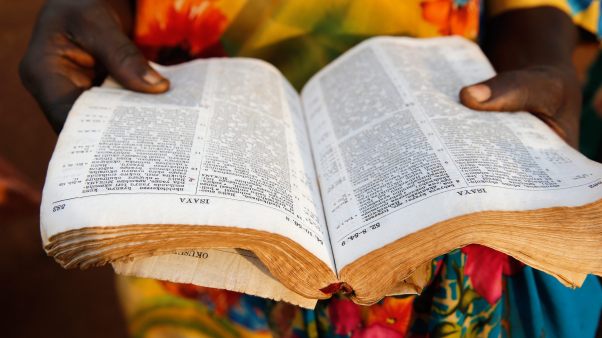We moderns are repelled by the thought of blood cleansing, but biologically and spiritually the precious liquid does exactly that.
Blood is life—spiritually and physically. Few persons are more appreciative of this truth than surgeon and devout Christian Paul Brand. In this and the following two issues, CT presents Brand’s striking insights, polished by writer Philip Yancey. Each essay may be understood exclusive of the others, but all explore the themes of blood and the Lord’s Supper.
I turn up the collar of my wool topcoat and bow my head against the penetrating, moisture-laden wind. Snowflakes are gradually transforming the tired modern city of London into a Dickensian Christmas card. On a deserted street I stop under an ancient street lamp and look up. Snow arcs around the lamp like an endless shower of electrical sparks, then floats down to cover pothole, gutter, car, and sidewalk alike with a uniform coat of softly glowing white.
From somewhere I hear music, muffled brass and what seems like human voices. On a night like this? I walk toward the sound and the music grows louder until I round a corner and see its source: a Salvation Army band. A man and a woman are playing a trombone and trumpet respectively, and I grimace as I imagine the effect of metal pressed against lips in the numbing wind. Three others, evidently new recruits, are lustily singing a hymn based on a poem by William Cowper.
Only two other people are listening: a drunken gentleman who is propping himself against the stone porch railing of a Georgian-style townhouse, and a businessman on the corner who keeps glancing at a pocket watch. The words are familiar to me:
There is a fountain filled with blood
Drawn from Emmanuel’s veins;
And sinners, plunged beneath that flood,
Lose all their guilty stains …
An unavoidable smile crosses my face as I hear those words. I have just come from hospital rounds, where I saw blood being drawn from some veins, transfused into others, and diligently scrubbed off surgical smocks and nurses’ uniforms. With my church background, I know the origin and meaning of that Christian hymn, but these other two bystanders, listening half-heartedly—what images fill their minds as they hear those words?
Would not such a phrase as “washed in the blood of the Lamb” seem to the modern Englishman as bizarre as a report of animal sacrifice being practiced in Indonesia?
We moderns have an initial resistance to the intrusion of blood into our religion. In this respect, we differ from all previous cultures. Virtually all “primitive” religions, including those of Rome and Greece, believed blood had sacramental power, and a bloodless religion would have seemed feckless to most ancients. To them, blood was an everyday substance. They killed their calves and chickens with knives before feasting, whereas we moderns select ours in shrink-wrapped packages, drained of blood and all reminder of slaughter.
Besides this unfamiliarity, an even greater barrier blocks off the meaning of the blood symbol from modern hearers. Consider the term “washed in the blood”: nothing in modern culture corresponds to the idea of blood as a cleansing agent. We use water, with soap or detergent, to clean. Blood is a soiling or staining agent, something we try to scrub off, not scrub with. What possible meaning could the hymn writer, and Bible writers before him, have intended?
The symbol of blood with its specific quality of cleansing appears throughout the Bible, from the earliest books to the latest. In Leviticus 14, for example, a priest sprinkles cleansing blood on the skin of a person with an infectious skin disease and on the mildewed walls of a plaster house. New Testament authors often refer to Jesus’ blood “cleansing” us (e.g., 1 John 1:7), and Revelation describes a multitude who “have washed their robes and made them white in the blood of the Lamb” (Rev. 7:14).
Does this frequent reference to blood indicate primitive Christianity’s distance from modern culture? To the contrary, in the case of this one symbol, blood, and its specific application of cleansing, modern medical science has shown that the meaning derives precisely from the function of the actual substance. Presumably, biblical writers did not know the physiology behind their metaphor, but the Creator chose a theological symbol with an exact analog in the medical world. All that we have learned about physiology in recent years confirms the accuracy of the still-jarring juxtaposition of blood and cleansing. The theological image immortalized by William Cowper’s hymn makes for good biology as well.
I suggest a simple experiment if you truly wish to grasp the function of blood as a cleansing agent. Find a blood pressure test kit and wrap the cuff around your upper arm. When it is in position, have a friend pump it up to about 200 mm. of mercury, a sufficient pressure to stop the flow of blood in your arm. Initially your arm will feel an uncomfortable tightness beneath the cuff. Now comes the revealing part of the experiment: perform any easy task with your cuffed arm. Merely flex your fingers and make a fist about ten times in succession, or cut paper with scissors or drive a nail into wood with a hammer.
The first few movements will seem quite normal as the muscles obediently contract and relax. Then you will feel a slight weakness. Almost without warning a hot flash of pain will strike, after maybe ten movements. Your muscles will cramp. If you force yourself to continue the simple task, you will likely cry out in absolute agony. Finally, you cannot will yourself to continue; the pain overwhelms you.
When you release the tourniquet and air escapes from the cuff, blood will rush into your aching arm and a wonderful sense of relief will soothe your muscles. The pain is worth enduring just to experience that acute relief. Your muscles move freely, the pain vanishes, and life feels good again. Physiologically, you have just experienced the cleansing power of blood.
While the blood supply to your arm was shut off, you forced your muscles to keep working. As they converted oxygen into energy, they produced certain waste products (metabolites) that are normally flushed away instantly in the bloodstream. Due to the constricted blood flow, however, these metabolites accumulated in your cells. They were not “cleansed” by the swirling stream of blood, and therefore in a few minutes you felt the agony of retained toxins.
The body performs its janitorial processes with such speed and efficiency that I must pause for at least a summary of them. Hold the theological metaphor in abeyance while I indulge in a quick scan of the body’s cleansing processes.
No cell lies more than a hair’s breadth from a blood capillary, lest poisonous by-products pile up and cause the same ill effects felt in the blood pressure cuff experiment. Through a basic chemical process of gas diffusion and transfer, individual red blood cells, traveling slowly inside narrow capillaries, simultaneously release their cargoes of fresh oxygen and absorb waste products (carbon dioxide, urea, and uric acid). The red cells deliver these potentially hazardous chemicals to organs that can dump them outside the body.
In the lungs, carbon dioxide collects in small pockets and is exhaled with every breath. The body monitors how long this process takes and makes instantaneous adjustments. If too much carbon dioxide accumulates, as when I climb a flight of stairs and expend more energy, an involuntary switch increases my breathing to speed up the process. (Conversely, no one can commit suicide by not breathing—the involuntary trigger “forces” you to.)
Complex chemicals are filtered out by a more discriminating organ, the kidney. I must restrain myself from writing long, rhapsodic pages about the kidneys. Some observers judge them second only to the brain in complexity. The body obviously values them greatly, for one-fourth of the blood from each heartbeat courses down the renal artery to the paired kidneys. That artery divides and subdivides into a tracery of tubules so intricate as to bedazzle the finest Venetian glass blower.
Filtering is what the kidney is all about, but in very little space and time—a new heartbeat pumps another gallon of blood through the floodgates each second. The kidney manages speed by coiling the tubules into two million crystal loops, where cells can be picked over one by one.
Red cells being too bulky for those tiny passageways, the kidney extracts all the sugars, salts, and water from each cell and deals with them separately. This segregation process roughly compares to a master mechanic who has a garage the size of a woodshed. To tune a car engine, he hoists it out of the car, disassembles and scours each individual valve, piston, and ring, then reassembles the hundreds of parts minus the grime and corrosion.
The kidney removes the red cell’s entire payload to distill some 30 chemicals; then its enzymes promptly reinsert 99 percent of the volume into the bloodstream. The 1 percent remaining, mostly ammonia, is hustled away to the bladder to await expulsion. One second later, the thunder of the heart resounds throughout the body and a gallon of fresh blood rushes in to fill the tubules.
An elite coterie of people in the world view the kidney with an attitude approaching reverence. These are the few without kidneys, or with useless kidneys. Thirty years ago all of those people would have died. Now they have much time to contemplate the wonders of the kidney—too much time. Twice a week for six hours they lie or sit motionless while a tube drains all their blood into a noisy, clanging, washing machine the size of a large suitcase. The function of this technological monster, a kidney dialysis machine, crudely approximates the intricate work of the soft, bean-shaped human variety. Ours, however, weighs only one pound and works around the clock. Just to be sure, our body provides a spare—one kidney would do the job just fine.
Other organs enter into the scavenging process also. A durable red cell can only sustain this rough sequence of freight loading and unloading for a quarter-million circuits or so and then, battered and leaky as a worn-out river barge, it is nudged to the liver and spleen for one last unloading. This time, the red cell itself is picked clean, broken down into amino acids and bile pigments for recycling. The tiny heart of iron, “magnet” for the crucial hemoglobin molecule, limps back to the bone marrow for reincarnation in another red cell. Four million red cells a second retire to the junkyard in my body; four million more leap from the marshes of bone marrow to begin their circuit of fueling and cleansing.
All this inquiry into the process of cleansing leads back to the meaning of the metaphor. Blood sustains life by carrying away the chemical by-products that would interfere with it. This, then, is the medical explanation of blood’s cleansing property. As I reflect on the body of Christ, the blood metaphor offers a fresh and enlightening perspective on a perpetual problem in that body: sin.
The word sin is dusty, timeworn, and freighted with unfortunate connotations. And the metaphors commonly used to describe God’s relationship with sinful creatures are equally onerous. God is the judge, we the accused—but although biblically accurate, that metaphor has lost much of its force as the modern legal system has grown less trustworthy and more capricious. Justice has become a formal code to be scrutinized and applied without compassion. Metaphors age over time; sometimes they crack, and the concepts inside them begin to spill out.
Yet in blood we have the perfect analog to reveal the process of sin and forgiveness with startling clarity. Forgiveness cleanses the wasteful products, sins, that impede true health, just as blood cleanses harmful metabolites.
Too often we tend to view sin as a private list of grievances that happen to irk God the Father. Laws were given for his sake, and in the Old Testament he seems easily irritated. But even a casual reading of the Old Testament shows that sin is a blockage, a paralyzing toxin that restricts our realization of full humanity. God gave laws for our sake, not for his own.
To realize the full meaning of romantic love, we must recognize the natural laws that govern an exclusive relationship. In a complete, fulfilling relationship with God and our neighbors, equally binding principles apply. When pride, egoism, lust, and covetousness take over, they poison us, interfering with those relationships. They must be purged out before we can become fully human. “Truly it is evil to be full of faults,” said Pascal, “but it is a still greater evil to be full of them, and to be unwilling to recognize them.”
Separation is at the root of sin: separation from God, other people, and our true selves. The more we cling to our private desires, our thirsts for success, our own satisfactions at the expense of others, the farther we will withdraw from God and others. The Old Testament Israelites had a vivid pictorial representaton of this state of separation: God’s Presence rested in a Most Holy Place, approachable only once a year (the Day of Atonement) by one man, the high priest, who had purified himself through an elaborate series of blood sacrifices. Jesus Christ made that ceremony obsolete by a historical once-for-all sacrifice. “This is my blood of the covenant, which is poured out for many for the forgiveness of sins” (Matt. 26:28, NIV), he said as he instituted the Last Supper. Later the author of Hebrews constrasted Christ’s complete, once-for-all sacrifice to the partial, annual rituals enacted by the high priest (Heb. 9:23–28). Christ became sacrificial victim as well as priest, conquering evil by forgiving it with his own blood.
The Lord’s Supper as celebrated today contrasts sharply with the Old Testament ceremony. Then, each worshiper had to go to a fixed geographical point to receive forgiveness at the hands of a designated priest. The stench of death, the sight of blood splattering an altar, the odor of burning flesh, a Holy of Holies off limits to everyone, an offering brought by each worshiper—these elements characterized that worship scene. Now, the Lord’s Supper expresses that Christ’s sacrifice was made continuous and ongoing. It is taken personally, into the interior of every member of his body. In other words, the same living blood that bathes every cell with the nutrients of life also carries away all the accumulated waste and refuse. By his blood we are forgiven, made clean.
No longer must we approach God through a purified priest, no longer await the Day of Atonement to enter the Holy of Holies. On the day Christ died, the thick temple veil separating God from man split from top to bottom. Now we, all of us, can enter into direct communion with him: “We have confidence to enter the Most Holy Place by the blood of Jesus, by a new and living way opened for us through the curtain, that is, his body” (Heb. 10:19, NIV). Or, again, “Now in Christ Jesus you who were once far away have been brought near through the blood of Christ” (Eph. 2:13).
The word Repentance describes the process of each cell undergoing that cleansing action. C. S. Lewis reminds us that repentance “is not something God demands of you before He will take you back and which He could let you off if He chose; it is simply a description of what going back is like.” In the terms of our analogy, in repentance each cell willingly cooperates with the available cleansing process of blood. It is for our sakes, not so much to punish us as to free us from the harmful effects of accumlating sins.
In addition to removing sin, Christ’s blood replaces it with his own righteousness. He manages a stuff exchange wholly to our benefit. “God made him who had no sin to be sin for us,” Paul said, “so that in him we might become the righteousness of God” (2 Cor. 5:21). “This is his body, broken for you”—for your gossiping, your lust, your pride, your insensitivity; broken to remove all those and replace them with his perfect obedience.
We humans do not take easily to forgiveness. The concept flies against reason. We are prepared for anything but this: a God who strikes hard bargains, yes, but not One who lets us off scot-free. Missionaries to remote peoples report that mercy is the most difficult concept of Christianity for them to grasp. We expect pain in approaching God, and fear; but unqualified, as-if-it-never-happened forgiveness stops us short. Perhaps for this reason the church has tempered forgiveness over the centuries, often seeming to prefer the morals business, distributing guilt, to the business of forgiveness, dispensing grace.
A fear lurks in each of us. Perhaps when God discovers the real truth, perhaps then he will stop loving us. We forget that, even among human relationships, when you love someone, his or her weaknesses and defects become part of the bond that pulls you closer. Not until that person lets you see true humanity do you feel you really know him or her. In an incomprehensible way this is how the Creator loves the creature, and is why Jesus lingered so often among adulterers, tax collectors, and Samaritans. It is why he favored the sinner over the Pharisee: the sinner was closer to God, not in similarity but in approach. Aware of the awful burden of his sins, he gladly released them to God’s forgiveness. The Pharisee, inhibited by pride, clung to his sins.
Why do any of us go to church and sit on rather uncomfortable furniture, in stiff clothes, lined up in rows as in a high school classroom, singing songs unlike any we have heard all week? Is it not because in each of us a spark of hope has been lit—a hope to be known, to be forgiven, to be healed, to be loved? Something like this yearning lies at the heart of the Lord’s Supper.
All symbols are weaker than the reality behind them, and we poorly perceive the reality behind the form. But Christ has given us the wine and the bread as proof that we are forgiven, healed, and loved. The symbol works its way inside us, becoming material as well as spiritual nourishment, carrying its message to individual cells throughout each body.
“What does my blood do all day?” a five-year-old child asked, while peering dubiously at his scraped knee. Whereas the ancients would have answered elegantly with references to ethers and humours carried by that “pure clear lovely and amiable juyce,” perhaps a technological metaphor would serve best today.
Imagine a plastic pneumatic tube snaking southward from Canada through Orinoco jungles, plunging into oceans only to surface at every inhabited island, shooting out eastward through every jungle, plain and desert in Africa, forking near Egypt to join all of Europe and Russia as well as the entire Middle East and Asia—a pipeline so global and all-pervading that it links every one of the four billion people worldwide. Inside that tube an endless plentitude of treasures floats along: 49 brands of cereals; mangoes, Kiwi fruit, asparagus, and other produce from every continent; watches, calculators, and cameras; genes and minerals; all styles and sizes of clothing; the contents of entire shopping centers. All four billion people have access: at a moment of need or want, you simply reach into the tube and seize whatever product suits your taste. Somewhere far down the pipeline a replacement is manufactured and inserted.
Such a pipeline exists inside each one of us, servicing not four billion but one hundred trillion cells in every person’s body. A stockpile of oxygen, amino acids, nitrogen, sodium, potassium, calcium, magnesium, sugars, lipids, cholesterols, and hormones surges past our cells on rafts of blood cells. Each cell has special withdrawal privileges and uses the resources to fuel a tiny engine, which carries out complex chemical reactions.
In addition, that same pipeline ferries away refuse, exhaust gases, and worn-out chemicals. In the interest of economical transport, the body dissolves its vital substances into a liquid, much as coal is shipped most efficiently through a slurry pipeline rather than by truck or train. Five or six quarts of this all-purpose fluid suffice for all hundred trillion cells.
In the Eucharist, we are reminded of the overarching forgiveness accomplished in Christ’s bloody sacrifice that made obsolete the whole Jewish sacrificial system. And we also experience the particular, cell-by-cell cleansing of toxins that have accumulated and will not easily release their grip. “For if, when we were God’s enemies, we were reconciled to him through the death of his Son, how much more, having been reconciled, shall we be saved through his life!” (Rom. 5:10, NIV). If sin is the great separator, Christ is the great reconciler. He dissolves the membrane of separation that grows up every day between ourselves and others, ourselves and God. “Now in Christ Jesus,” said Paul elsewhere, “you who were once far away have been brought near through the blood of Christ. He himself is our peace.”
Near the end of his life, François Mauriac, the French Catholic novelist who received the Nobel Prize for Literature, reflected on his own love-hate history with the church. He detailed the ways in which the church had not kept its promise: the petty rifts and compromises that have characterized it throughout history. The church, he said, had strayed far from the precepts and example of its founder. And yet, added Mauriac, despite all its failings the church had at least remembered two words of Christ: “Your sins are forgiven you,” and “This is my body broken for you.” The Lord’s Supper brings together those two words in a quiet ceremony of healing, cleansing individual cells in his Body of all impurities.










